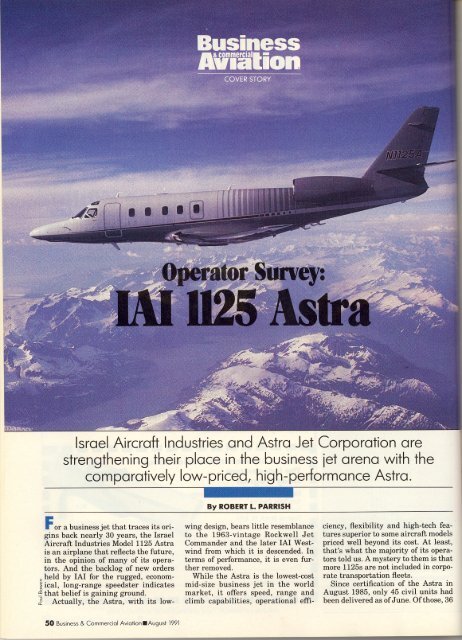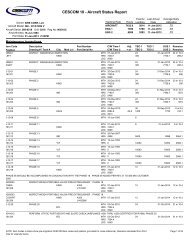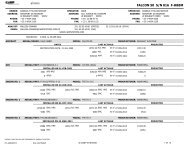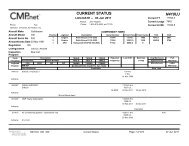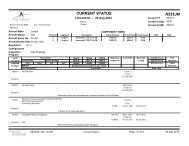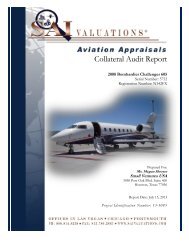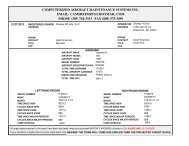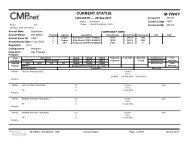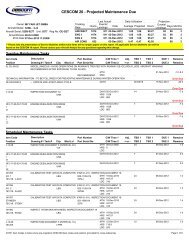Israel Aircraft Industries and Astra Jet ... - Omni Jet Trading
Israel Aircraft Industries and Astra Jet ... - Omni Jet Trading
Israel Aircraft Industries and Astra Jet ... - Omni Jet Trading
Create successful ePaper yourself
Turn your PDF publications into a flip-book with our unique Google optimized e-Paper software.
-<br />
<strong>Israel</strong> <strong>Aircraft</strong> <strong>Industries</strong> <strong>and</strong> <strong>Astra</strong> <strong>Jet</strong> Corporation are<br />
strengthening their place in the business jet arena with the<br />
comparatively low-priced, high-performance <strong>Astra</strong>.<br />
By ROBERT L. PARRISH<br />
For a business jet that traces its origins<br />
back nearly 30 years, the <strong>Israel</strong><br />
<strong>Aircraft</strong> <strong>Industries</strong> Model 1125 <strong>Astra</strong><br />
is an airplane that reflects the future,<br />
in the opinion of many of its operators.<br />
And the backlog of new orders<br />
c held by IAI for the rugged, econom<br />
~ical, long-range speedster indicates<br />
~ that belief is gaining ground.<br />
~ Actually, the <strong>Astra</strong>, with its low-<br />
50 Business & Commercial Aviation.August 1991<br />
wing design, bears little resemblance<br />
to the 1963-vintage Rockwell <strong>Jet</strong><br />
Comm<strong>and</strong>er <strong>and</strong> the later IAI Westwind<br />
from which it is descended. In<br />
terms of performance, it is even further<br />
removed.<br />
While the <strong>Astra</strong> is the lowest-cost<br />
mid-size business jet in the world<br />
market, it offers speed, range <strong>and</strong><br />
climb capabilities, operational effi-<br />
ciency, flexibility <strong>and</strong> high-tech features<br />
superior to some aircraft models<br />
priced well beyond its cost. At least,<br />
that's what the majority of its operators<br />
told us. A mystery to them is that<br />
more 1125s are not included in corporate<br />
transportation fleets.<br />
Since certification of the <strong>Astra</strong> in<br />
August 1985, only 45 civil units had<br />
been delivered as ofJune. Of those, 36
are flown by 34 U.S. corporate <strong>and</strong><br />
charter operations. <strong>Astra</strong> <strong>Jet</strong> Corporation<br />
in Princeton, New Jersey, the<br />
U.S. subsidiary of IAI charged with<br />
responsibility for worldwide marketing<br />
<strong>and</strong> product support, claims the<br />
Model 1125 sales backlog extends<br />
through 1992, if IAl's production rate<br />
of one <strong>Astra</strong> per month remains<br />
unchanged.<br />
Powered by two 3,700-pound-thrust<br />
Garrett TFE731-3A-200G turbofans,<br />
the six- to nine-passenger <strong>Astra</strong> carries<br />
a 1991 B/CA-equipped price of<br />
$7,140,593. Its 23,650-pound max<br />
ramp weight (24,650 pounds with a<br />
modification) incorporates 9,365<br />
U.S. operators (where an even 80 percent<br />
of the worldwide <strong>Astra</strong> fleet presently<br />
is based), B/CA found some distinct<br />
departures from user surveys of<br />
the past.<br />
For example, the <strong>Astra</strong> was the first<br />
aircraft acquired by a number of companies.<br />
Among long-term users,<br />
where br<strong>and</strong> loyalty has been a prominent<br />
factor in previous surveys, only<br />
about 25 percent of those contacted<br />
had progressed from IAl's 1124/24A<br />
Westwind series. For a significant<br />
number of companies, the <strong>Astra</strong> represented<br />
a full commitment. That is,<br />
it was not introduced on a tentative<br />
basis, but was an immediate replace-<br />
Features named as best-liked include the <strong>Astra</strong>'s general performance, comfort<br />
levels in both cockpit <strong>and</strong> passenger compartments, <strong>and</strong> its soft ride.<br />
/,.,.~ ~<br />
pounds of fuel, which gives the aircraft<br />
an NBAA IFR max-fuel range of<br />
more than 2,700 nm under ISA nowind<br />
conditions.<br />
At the same time, note its users, the<br />
airplane's operational flexibility,<br />
short-field capabilities with relatively<br />
high useful loads, climb characteristics<br />
<strong>and</strong> Mach 0.80 to Mach 0.82<br />
speeds make it a unique member of<br />
the corporate aircraft fleet. Coupled<br />
with that, most U.S. firms employing<br />
the <strong>Astra</strong> feel that both <strong>Astra</strong> <strong>Jet</strong> <strong>and</strong><br />
its parent IAI have been extraordinarily<br />
responsive to their suggestions,<br />
complaints <strong>and</strong> needs.<br />
DEPARTURES FROM THE PAST<br />
In this survey of <strong>Astra</strong> users that<br />
encompassed nearly 80 percent of<br />
ment for an aircraft with less range,<br />
speed <strong>and</strong> capacity.<br />
Delivery dates of units included in<br />
the survey ranged from late 1986<br />
through January 1991, <strong>and</strong> total<br />
flight hours accumulated spanned<br />
from a low of about 150 up to nearly<br />
1,900. As a group, the aircraft are<br />
flown an average of507 hours annually,<br />
from a low of250 to a high of more<br />
than 700, over average stage lengths<br />
of 695 nm. Positioning flights of 10 to<br />
50 nm <strong>and</strong> mission stage lengths from<br />
75 nm to more than 2,600 nm were<br />
reported. Passenger number per trip<br />
ranged from 1.2 to six, with an average<br />
of 4.8 in surroundings most<br />
commonly configured for seven<br />
occupants.<br />
Because of the <strong>Astra</strong>'s reportedly<br />
superior climb performance, most<br />
operators said they are able to achieve<br />
initial cruise altitudes at near-gross<br />
of FL 370 to FL 390 without stepclimbing,<br />
ATC permitting. Ultimate<br />
cruise altitudes ofFL 410 to FL 430with<br />
an occasional FL 450 certificated<br />
ceiling reached-were achieved most<br />
commonly on legs of more than 1,000<br />
nm.<br />
Remarkable uniformity in cruise<br />
speeds of Mach 0.80 to 0.82 was<br />
apparent for most trips of 350 nm or<br />
more, including transcontinental<br />
flights. Several operators note,d,however,<br />
that at near gross under ISA<br />
plus conditions, steppin Ina¥---Qerequired<br />
to achieve an altitude a1>o~e<br />
FL 350, <strong>and</strong> speeds ay be limited to<br />
Mach 0.76 to 0.78/until a substantial<br />
amount of fuel has been burned.<br />
Average fuel flo~s also were found<br />
to be quite consistent.~F'irst-hour consumption<br />
was calculated at 2,000<br />
pounds. Reported second-hour rate<br />
was 1,650 to 1,800 pounds, <strong>and</strong> thirdhour<br />
burn was 1,400 to 1,600 pounds,<br />
with about 100 pounds less used for<br />
each subsequent hour. Two chief pilots<br />
computed fuel consumption on<br />
the basis of overall hours flown. They<br />
put their burn rates at 1,700 <strong>and</strong><br />
1,550 pounds per hour, respectively.<br />
Not surprisingly, the highest firsthour<br />
<strong>and</strong> overall fuel burn levels were<br />
reported by operators based in or near<br />
Northeast Corridor airspace control<br />
areas.<br />
What came as a mild surprise was<br />
that, even though the perfoqnance<br />
profile of the <strong>Astra</strong> reportedly was<br />
conceived to enhance its value in international<br />
use, missions performed<br />
by U.S. operators have been predominantly<br />
domestic, as illustrated by the<br />
average trip lengths. Just a few operators<br />
acknowledged that transoceanic<br />
travel needs were factors in their<br />
selection of the <strong>Astra</strong>. One disclosed<br />
that some 25 percent of his airplane's<br />
450 hours per year are accumulated<br />
during transcontinental trips. For<br />
others, international travel accounted<br />
for less than 10 percent of total flight<br />
time.<br />
From the st<strong>and</strong>point of economy,<br />
inflated fuel prices in some areas were<br />
blamed for direct operating costs being<br />
on average somewhat higher than<br />
projected or than IAI estimates. It was<br />
stressed by several of our contacts,<br />
however, that the aircraft operating<br />
manual itself is extremely accurate<br />
with regard to performance parameters.<br />
DOCs were not reported by all<br />
respondents, but those that were<br />
ranged from a low of $700 per hour to<br />
Business & Commercial Aviotion.August 1991Sl
a high of $855 per hour, with an average<br />
of $789.57. (Excluded from this<br />
are the DOCs for four <strong>Astra</strong>s employed<br />
in FAR Part 135 service, <strong>and</strong><br />
one for which the chief pilot revealed<br />
data only on total operating cost. Figures<br />
for these few aircraft were between<br />
$1,200 <strong>and</strong> $1,500 per flight<br />
hour.)<br />
FROM THE FIELD<br />
Statistical compilations do not disclose<br />
the worth placed on a business<br />
tool by its users, <strong>and</strong> several operators<br />
stressed that their <strong>Astra</strong> is highly<br />
regarded as such by company management.<br />
An aircraft's ability to perform<br />
required transportation missions<br />
safely, with high reliability,<br />
perhaps is paramount. Of significance<br />
S2 Business& Commercial Aviation.August 1991<br />
to several operators in this respect<br />
was that they've never had to cancel a<br />
mission because the <strong>Astra</strong> was down<br />
or considered unsafe to perform a<br />
trip.<br />
As one flight department manager<br />
noted, every aircraft ever produced<br />
reflects compromises made in order to<br />
maximize particular features. "We<br />
find the <strong>Astra</strong> to be the best compromise<br />
in performing everything our executives<br />
want it to," he said.<br />
Nearly every pilot <strong>and</strong> maintenance<br />
technician interviewed expressed<br />
similar sentiments, even<br />
though each also was able to point out<br />
what they believe to be design or operational<br />
shortcomings of the <strong>Astra</strong>.<br />
The most significant of those either<br />
have been or are being addressed by<br />
<strong>Astra</strong> <strong>Jet</strong> reports that several<br />
improvements have been made in<br />
windshield design <strong>and</strong> fabrication.<br />
<strong>Astra</strong> <strong>Jet</strong> <strong>and</strong> IAI through ongoing<br />
product improvement efforts, an <strong>Astra</strong><br />
<strong>Jet</strong> spokesman indicated.<br />
Without attempting to qualify the<br />
perceived shortcomings in terms of<br />
frequency or apparent magnitude to<br />
operators, presented below are summations<br />
of <strong>Astra</strong> operator comments<br />
with regard to best-liked <strong>and</strong> leastliked<br />
features <strong>and</strong> problems experienced,<br />
as well as a brief view at what<br />
<strong>Astra</strong> <strong>Jet</strong> <strong>and</strong> IAI have done to' enhance<br />
the product.<br />
Features named as best-liked include<br />
the <strong>Astra</strong>'s general performance-climb<br />
capability, quietness,<br />
balanced field lengths, speed <strong>and</strong><br />
range-the EFIS, comfort levels in<br />
both cockpit <strong>and</strong> passenger compartments,<br />
structural ruggedness, soft<br />
ride (achieved with the aid of the airplane's<br />
flexing wing), baggage <strong>and</strong><br />
fuel capacity, reliability, maintainability<br />
<strong>and</strong> product support.<br />
Items on the least-liked side were<br />
windshield delamination, malfunctioning<br />
seat mechanisms, the comparative<br />
narrowness of the passenger<br />
compartment, the height of the aft<br />
baggage area from the ground <strong>and</strong> its<br />
lack of pressurization, <strong>and</strong> uneven<br />
ECU distribution. A ramp "sitting<br />
posture" at lighter weights that necessitates<br />
the use of "<strong>Astra</strong> bricks"<br />
beneath the air stair door also was<br />
listed here, as were location, shape<br />
<strong>and</strong> sensitivity of rudder <strong>and</strong> aileron<br />
trim tab controls in the cockpit.<br />
Other perceived problems were<br />
water in the nose avionics bay; flap/<br />
slat system malfunctions; main doorclosing<br />
<strong>and</strong> sealing characteristics;<br />
nosewheel steering <strong>and</strong> braking deficiencies;<br />
noisy bleed-air cabin inlet<br />
valves; parts catalog errors; corrosion<br />
<strong>and</strong> arcing of electrical components,<br />
which are attributed to the use of aluminum<br />
buss bars; fuel leaks <strong>and</strong> erroneous<br />
fuel system readings; slow<br />
rate <strong>and</strong> noisiness of refueling; the<br />
step-down aisle, which was "fixed" by<br />
one operator via construction of an onboard<br />
aisle ramp; VREF speeds; inspection<br />
panel fastener disposal rates<br />
<strong>and</strong> replacement costs; air-cycle machine<br />
failures; the quality of interior<br />
outfitting <strong>and</strong> external paint; <strong>and</strong><br />
replacement parts prices, a problem<br />
which depended upon the source<br />
used.<br />
Three cautions must be appended to<br />
this listing of least-liked features.<br />
One is that many of the grievances
have been resolved via service bulletins<br />
or improvements in subsequent<br />
production units, though memory of<br />
problemspast apparently lingers on.<br />
Secondis that many of the issues were<br />
mentioned by only one or a few of<br />
thoseinterviewed. In some cases, we<br />
sensed that interviewees felt some<br />
sortof negative comment was obligatoryto<br />
temper their own bias in favor<br />
ofthe <strong>Astra</strong>. Third, the vast majority<br />
of respondents emphasized their beliefthat<br />
the "plusses" of the <strong>Astra</strong> far<br />
exceedthe minor annoyances or dissatisfactions<br />
cited.<br />
That is not to imply that problems<br />
experienced by operators have been<br />
taken lightly by IAI. By far the most<br />
serious <strong>and</strong> apparently widespread<br />
complaintdealt with the windshield's<br />
tendency to delaminate or lose the<br />
abilityto bleed off P-static discharge.<br />
Fully half the survey sample complained<br />
of having to replace one or<br />
both windshield panels, <strong>and</strong> there<br />
wasgeneral concern that the problem<br />
stillmay not be fully resolved.<br />
<strong>Astra</strong> <strong>Jet</strong> says several improvementshave<br />
been made in windshield<br />
design <strong>and</strong> fabrication. For P-static<br />
bleed-off,the vendor is now applying<br />
a modified tin oxide coating to the<br />
outersurface, <strong>and</strong> metal tape is being<br />
placedunder the windshield frame to<br />
inhibit formation of moisture, which<br />
wasblamed for causing delamination.<br />
Windshields incorporating those<br />
changeshave shown very satisfactory<br />
service,it was claimed. However, to<br />
further ensure customer satisfaction,<br />
the new aircraft warranty was doubled<br />
to two years, <strong>and</strong> the cost of<br />
windshields found to be defective<br />
beyondthat time has been reduced by<br />
34 percent, reportedly to about<br />
$37,000per panel.<br />
In response to complaints about<br />
nose-steering control, the original<br />
straight nose gear lower strut assembly<br />
was replaced with one that providesa<br />
two-inch trailing caster. The<br />
controlsystem also was redesigned to<br />
desensitize input signals. <strong>Astra</strong> <strong>Jet</strong><br />
claims that nose-steering problems<br />
have been fully resolved. Indeed, a<br />
fewoperators commented that the <strong>Astra</strong>'s<br />
steering qualities were among<br />
the best to which they have been<br />
exposed.<br />
Hydraulic system problems that<br />
plagued several early production<br />
units, affecting bleed-air functions<br />
<strong>and</strong>braking sensitivity, stimulated at<br />
least three modifications on the production<br />
line. These reportedly have<br />
been retrofitted to most units in the<br />
field,according to <strong>Astra</strong> <strong>Jet</strong>, dimin-<br />
As a group, the<br />
aircraft are flown<br />
an average of 507<br />
hours annually.<br />
ishing instances of "duck-walking," a<br />
reaction caused by the tendency of<br />
some pilots to apply more pressure to<br />
one side than the other, particularly<br />
when l<strong>and</strong>ing short.<br />
With regard to the cabin airstair<br />
door's heaviness <strong>and</strong> broken springs,<br />
operators' 'comments indicated that a<br />
substantial measure of dissatisfaction<br />
still exists. <strong>Astra</strong> <strong>Jet</strong> said continuing<br />
design changes <strong>and</strong> modifications<br />
have resulted in a need for less lifting<br />
force to get the door off the ramp, as<br />
well as affording improved reliability<br />
of internal door axle components. The<br />
issue is addressed fully in a service<br />
bulletin that was due to be published<br />
in June or July.<br />
A major cause for incidents of flap/<br />
slat malfunctions or locking up on<br />
early <strong>Astra</strong>s was reported to be a rigging<br />
situation that developed into a<br />
nagging situation because appropriate<br />
test equipment did not exist.<br />
An <strong>Astra</strong> <strong>Jet</strong> tech rep is credited with<br />
having devised equipment to overcome<br />
that dilemma, but improvements<br />
made to actuators by the flap/<br />
slat vendor were provided to operators<br />
at no cost. <strong>Astra</strong> <strong>Jet</strong> claims system<br />
integrity <strong>and</strong> reliability now fully<br />
meet MTBF expectations.<br />
The company also says measures<br />
have been taken to overcome water<br />
intrusion into the 1125's nose avionics<br />
bay. Among them are improvements<br />
in quality control procedures to<br />
ensure a tight fit <strong>and</strong> finish to nose<br />
canopy installation, plus a redesign of<br />
nose ventilation to deter the formation<br />
of condensation during fast descents<br />
into humid conditions.<br />
Fixes are in the works for fuel system<br />
problems, but some entail costs<br />
that are unacceptable to several of the<br />
operators interviewed. And although<br />
the <strong>Astra</strong> was designed <strong>and</strong> tested to<br />
FAR Part 25 fatigue <strong>and</strong> damage<br />
tolerance criteria, which require no<br />
demating or x-ray inspection for the<br />
20,000-hour airframe life, fatigue<br />
cracking has been found in the horizontal<br />
stabilizer aft spar center splice<br />
on some aircraft.<br />
An AD therefore was issued in 1990<br />
requiring repetitive visual inspec-<br />
tions of the suspect portion each 200<br />
flight hours. IAI engineers reportedly<br />
are evaluating a new component that<br />
could obviate the requirement.<br />
To many of those participating in<br />
B/CA's survey, <strong>Astra</strong> <strong>Jet</strong>'s active<br />
quest over the past six months or so to<br />
ferret out problems or annoyances regarding<br />
operation of the IAI machine<br />
was ample cause to rate product support<br />
as one of the best-liked features.<br />
While certainly not unanimous, the<br />
opinions belied contentions made<br />
elsewhere that IAI aircraft have suffered<br />
from lack of support.<br />
BEHIND THE SCENES<br />
Technically, marketing <strong>and</strong> product<br />
support for the <strong>Astra</strong> were vested in<br />
IAI's newly formed subsidiary in January<br />
1988. The operation at that time<br />
apparently consisted of <strong>Astra</strong> <strong>Jet</strong><br />
President RoyBergstrom working out<br />
of an office in the basement of his<br />
home. On January 1, 1991, <strong>Astra</strong> <strong>Jet</strong><br />
formally took over from Atlantic Aviation<br />
full responsibility for Model<br />
1125 spares provision <strong>and</strong> distribution.<br />
Today <strong>Astra</strong> <strong>Jet</strong> boasts a staff of<br />
55, including 10 tech reps, <strong>and</strong> is<br />
reported to be in the process of exp<strong>and</strong>ing<br />
<strong>and</strong> refining a U.S. authorized<br />
service center network that in<br />
June included about a dozen of the<br />
most reputable maintenance facilities<br />
in the country.<br />
Every pilot <strong>and</strong> maintenance chief<br />
taking part in our survey spoke highly<br />
of the capabilities <strong>and</strong> helpfulness<br />
of their assigned tech reps. Even most<br />
of those who were critical of factors<br />
like parts a vailabili ty <strong>and</strong> cost<br />
acknowledged that they believe <strong>Astra</strong><br />
<strong>Jet</strong> is making extraordinary efforts to<br />
establish IAI as the most product-supportive<br />
manufacturer in the<br />
business.<br />
Said one flight department manager,<br />
"The thing that impresses me<br />
most about <strong>Astra</strong> <strong>Jet</strong> is that its people<br />
appear to be listeniJ,lgto their customers<br />
<strong>and</strong> acting on complaints or suggestions.<br />
Problems are not necessarily<br />
resolved immediately, but they let<br />
us know that it's being worked on."<br />
The maintenance chief in another<br />
department echoed that opinion. "I<br />
serve on the maintenance advisory<br />
board for the <strong>Astra</strong>, as well as that of<br />
another major manufacturer," he disclosed,<br />
"<strong>and</strong> the difference in reception<br />
of ideas <strong>and</strong> suggestions is that<br />
between night <strong>and</strong> day. I can only say<br />
<strong>Astra</strong>'s product support program is<br />
good <strong>and</strong> getting better." And that is<br />
how good business aviation markets<br />
are developed. SICA<br />
Business& Commercial Aviation.August 1991S3


